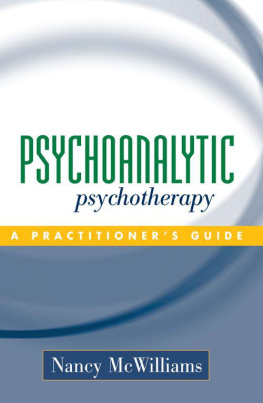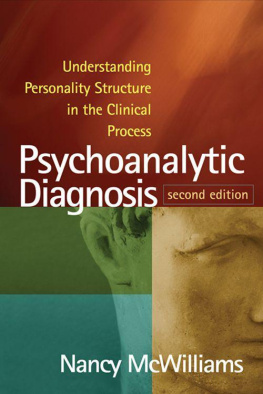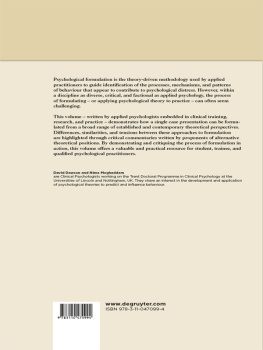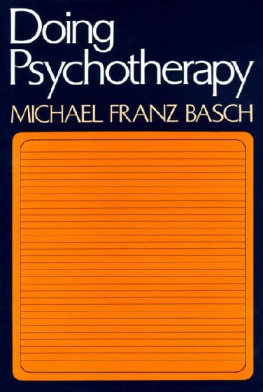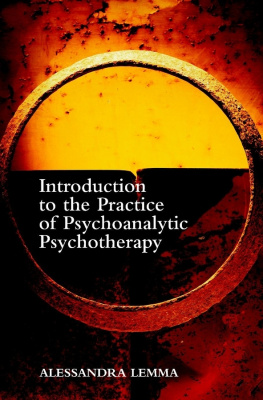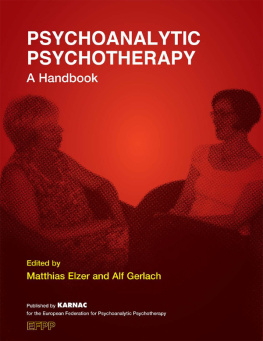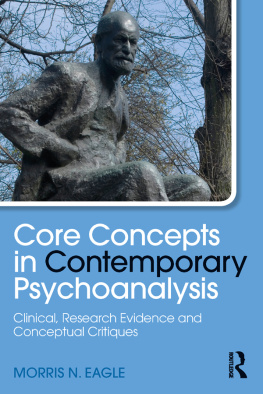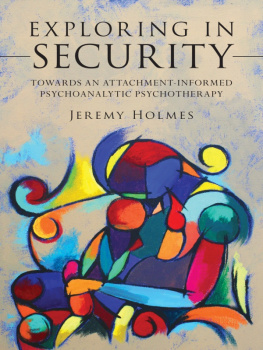2004 Nancy McWilliams
Published by The Guilford Press
A Division of Guilford Publications, Inc.
72 Spring Street, New York, NY 10012
www.guilford.com
All rights reserved
2004 Epub Edition ISBN: 9781606235829
No part of this book may be reproduced, translated, stored in a retrieval system, or transmitted, in any form or by any means, electronic, mechanical, photocopying, microfilming, recording, or otherwise, without written permission from the Publisher.
Last digit is print number: 9 8 7 6 5 4 3
Library of Congress Cataloging-in-Publication Data
McWilliams, Nancy.
Psychoanalytic psychotherapy : a practitioners guide / Nancy McWilliams.
p. ; cm.
Includes bibliographical references.
ISBN 978-1-59385-009-8
1. Psychoanalysis. I. Title.
[DNLM: 1. Psychoanalytic Therapy. WM 460.6 M478p 2004]
RC504.M33 2004
616.8917dc22
2003025342
For Art Robbins, with thanks
Nancy McWilliams, PhD, teaches psychoanalytic theory and therapy at the Graduate School of Applied and Professional Psychology at RutgersThe State University of New Jersey. A 1978 graduate of the National Psychological Association for Psychoanalysis, she also teaches for the Institute for Psychoanalysis and Psychotherapy of New Jersey, the National Training Program in Contemporary Psychotherapy, the Psychoanalytic Institute of Northern California, and the Minnesota Institute for Contemporary Psychoanalytic Studies. She has lectured throughout the United States and in Canada, Mexico, Russia, Sweden, Greece, Turkey, Australia, and New Zealand. Dr. McWilliams has a private practice in psychoanalysis, psychodynamic therapy, and supervision in Flemington, New Jersey, and is the author of Psychoanalytic Diagnosis: Understanding Personality Structure in the Clinical Process (Guilford Press, 1994) and Psychoanalytic Case Formulation (Guilford Press, 1999) as well as articles and book chapters on personality, psychopathology, psychotherapy, altruism, sexuality, and gender.
P sychology may be a science but psychotherapy is an art. Over the past century, having started as an effort to cure the baffling symptoms of patients with severe hysterical problems, psychodynamic therapies have been refined and expanded in attempts to reduce the suffering of an increasingly broad and diverse range of people. The impetus for this book is my sense that despite an abundance of good writing on the psychotherapy process, we lack an integrative work on psychotherapy that introduces students of the art to its essential featuresacross populations, across pathologies, across the sometimes radically differing paradigms currently in vogue in the psychoanalytic community, across the variations in human misery that express the idiosyncracies of particular families in particular places in a particular age. That such a book is a product of its own era and culture is inevitable. I am hoping that nonetheless it will be more embracing and less narrow than most previous primers on analytic therapy. As with my previous texts, with this book I am trying to be helpful mostly to people in training, whether in psychology, counseling, psychiatry, general medical practice, social work, nursing, or faith-based practice.
In addition to trying to address the training needs of beginning therapists, I am hoping to start a conversation about therapy that traverses theoretical orientations and professional disciplines. Perhaps by discussing central aspects of psychodynamic practice across diverse patient populations, I can effectively represent the psychoanalytic tradition to colleagues who are put off by arcane terminology and the trappings of a historically much too smug fraternity. My personal experience attests to what some researchers have dubbed the dodo bird phenomenon (Luborsky, Diguer, Luborsky, Singer, & Dickter, 1993), the observation that the common features of effective therapies operate similarly, independently of the ideologies of individual practitioners (Weinberger, 1995; Luborsky et al., 2002). My colleague Brenna Bry is a Skinnerian. My language for what I do is radically different from hers, but when I watch videotapes of her work, I notice that I would intervene in much the same way she does. If I can capture some elements of these common features in ways that are less vague than concepts such as personal warmth and empathy, I may be able to make what happens in psychodynamic psychotherapy not only comprehensible to novice analytic therapists but also interesting to colleagues of different explanatory leanings and to the educated nonprofessional reader.
My version of the dodo bird is not reductionistic; it does not negate the fact that there are effective, focused treatments for specific pathologies. We are, in the early years of the twenty-first century, in possession of cognitive-behavioral strategies that ameliorate many discrete disorders, medical interventions that transform psychoses and severe mood disorders, meditative disciplines that reduce anxiety and depression, and grass-roots-inspired movements like the twelve-step programs that have made addictions much more conquerablenot to mention countless other examples of particular weapons against particular ills. People who seek psychotherapy are generally looking both for specific expertise and for the kind of relationship that will allow them to unburden themselves and grow in a more general way.
Notwithstanding that some qualities are unique to a psychoanalytically oriented approach, much of its healing potential is shared by therapists of all sorts. Although my attitude about this derives from personal experience, it is compatible with some very stringently conducted research. Analyzing the work of Luborsky et al. (2002), Messer and Wampold (2002) observe that the current emphasis on empirically supported treatments is based on a discredited medical model and has contributed to an empirically unwarranted devaluation of the experiential, psychodynamic, and family therapies. They further conclude that specific, symptom-targeted strategies are effective only insofar as they are a component of a larger healing context, and that (as we have known for a long time) more variance in outcome arises from differences among therapists than from differences among treatment approaches. Perhaps there is a contradiction in my being both passionate about the special value of a psychoanalytic sensibility and sincere in my appreciation for the contributions of competing perspectives. But much as Winnicott asked therapists to embrace paradox, I hope my readers will be sympathetic to my seeing things from several different angles at once.
Part of what has impelled me to take on the task of writing another textbook is having witnessed the confusion of my students as they try to translate their own understanding of effective therapy into interventions that help clients with borderline, narcissistic, antisocial, posttraumatic, and symbiotic character pathology. Currently, even in the private offices of experienced practitioners serving sophisticated clients, and in the college counseling centers originally established to address normal growing pains, most consumers of therapy are not suffering from what analysts consider neurotic-level problems. They are enduring miseries that represent developmental arrests, insufficiencies of internalization, severe attachment disorders, addiction, and other catastrophes of an unkind fortune. Many of the graduate students at Rutgers University, where I teach, have been in conventional psychodynamic therapy of an uncovering sort, in which the traditional technique of attention to the transference and its historical antecedents has been deeply helpful. They have also been exposed to texts on psychoanalytic therapy that have aimed at teaching people how to work with clients who have good observing egos, self and object constancy, some sense of personal agency, and a vision of how they want to change. When they try to apply this version of help to their clients, they are dismayed to find themselves experienced as critical, attacking, mechanical, uncaring, or controlling.

